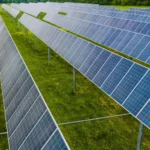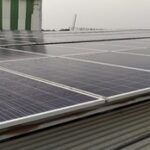Breakthrough in Solar Technology: 33.2% Efficient Perovskite-Silicon Cell
Breakthrough in Solar Technology: 33.2% Efficient Perovskite-Silicon Cell
Scientists at the King Abdullah University of Science and Technology (KAUST) claimed to have created a perovskite-silicon tandem solar cell with a record energy conversion efficiency of 33.2%.
The efficiency achieved at the KAUST Solar Center has been certified by the European Solar Test Installation (ESTI) and listed on the National Renewable Energy Laboratory’s (NREL) Best Research-cell Efficiency Chart.
Researchers combined perovskite top cells on industrially compatible, two-sided, textured silicon bottom cells to obtain the tandem solar cell.
They observed that the perovskite top layer absorbed blue light best, while the silicon foundation absorbed red light best.
The KASUT team has been working on how to uniformly cover the micrometer-sized pyramidal surface of silicon cells with perovskite material since 2016.
The scientists found that combining these materials increased the capture and conversion of sunlight into electricity more efficiently than the conventional single-junction silicon counterparts.
Professor of Material Science and Engineering and Interim Associate Director of the KAUST Solar Center Stefaan De Wolf said, “This new record is the highest power conversion efficiency of any two-junction solar cell under non-concentrated light, showing the great potential of perovskite/silicon tandems to deliver ultra-high performance photovoltaic modules, which is critical to quickly achieve renewable energy goals towards fighting climate change.”
The research is a major breakthrough in the field of solar energy at a time when market predictions estimate the tandem perovskite/silicon technologies will make up over $10 billion of the global photovoltaic market share by 2032.
The KAUST team is exploring scalable methods to produce industrial-scale perovskite/silicon tandem cells with areas exceeding 240 square centimeters.
The efficiency achieved by the KASUT team also surpassed the earlier record of 32.5% achieved by researchers at the Helmholtz-Zentrum Berlin for tandem solar cells.
Last month, Italy-based renewable energy company Enel Green Power, researchers at the National Solar Energy Institute, and the French Alternative Energies and Atomic Energy Commission claimed to have achieved a power conversion efficiency of 26.5% for a 2-terminal tandem perovskite solar cell.
Suggested Articles

Rooftop Solar for Factories: Maximum kW You Can Install
Industrial rooftop solar guide: Understand KW capacity limits, installation guidelines, and best practices for factories and manufacturing units

6 Upcoming Renewable Energy Events in India You Should Attend
The World Environment Expo, 2022 is a business platform that allows national and international equipment

Everything You Need to Know About Net Metering
Discover everything about net metering – how it works, benefits, installation process, and how it helps you save on electricity bills.

New IREDA Loan Scheme for Solar Rooftop Projects: Benefits, Eligibility & Interest Rates
India’s renewable energy push gets a major boost with the new IREDA loan scheme for solar rooftop projects. This scheme offers low-interest financing, simplified approvals, and better support for residential, commercial, and industrial consumers. Here’s a detailed look at its benefits, eligibility, interest rates, and how to apply for funding.

How Are Solar PV Modules Made? Complete Guide to the Manufacturing Process
Choosing the right solar panels can be confusing with so many options in the market. This guide simplifies solar panel selection by comparing types, efficiency ratings, and cost factors. Whether for your home, business, or industry, learn how to make an informed decision and maximize the return on your solar investment.

Delhi charges one of the highest tariffs for commercial load and industrial – average over Rs 10.00 per kWh
Delhi imposes some of the highest electricity tariffs for commercial and industrial consumers, averaging over ₹10 per kWh, impacting businesses and operating costs

Law Change Makes It Hard to Receive Compensation for Solar Developers
A recent law change creates hurdles for solar developers seeking compensation, impacting project viability.

Solar Inverters India: How to Choose the Best for Your Solar System
India’s solar market offers a wide range of inverters, making selection challenging. This guide explains key factors to consider, helping users choose the right inverter for residential, commercial, and industrial solar projects effectively.